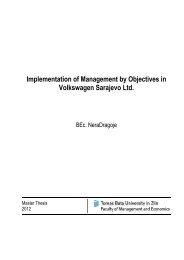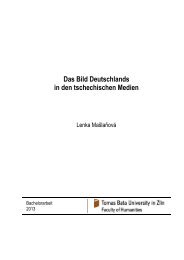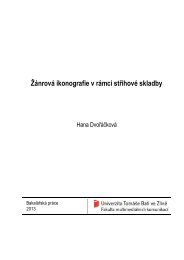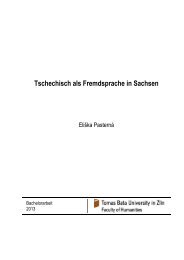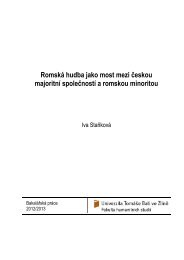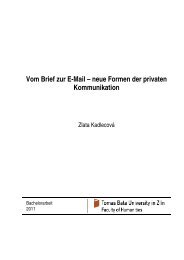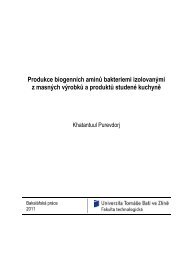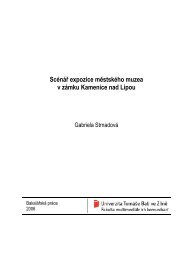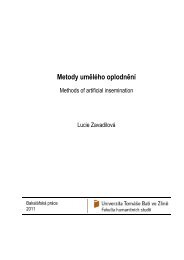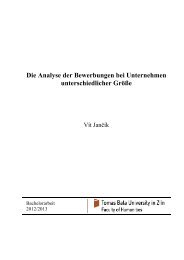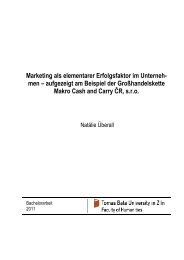The study of using of nanofillers in polyolefinic matrix - DSpace UTB
The study of using of nanofillers in polyolefinic matrix - DSpace UTB
The study of using of nanofillers in polyolefinic matrix - DSpace UTB
Create successful ePaper yourself
Turn your PDF publications into a flip-book with our unique Google optimized e-Paper software.
Tomas Bata University <strong>in</strong> Zlín, Faculty <strong>of</strong> Technology<br />
First publication, Polyolef<strong>in</strong>/Clay Nanocomposites: Compar<strong>in</strong>g <strong>of</strong> Mechanical and Barrier<br />
Properties, was concentrated on the matter <strong>of</strong> use <strong>of</strong> polymer/clay nanocomposite <strong>in</strong> food<br />
packag<strong>in</strong>g <strong>in</strong>dustry. Packag<strong>in</strong>g materials were prepared and follow<strong>in</strong>g this tested to gas<br />
permeability. <strong>The</strong> additional measurements were <strong>study</strong> <strong>of</strong> mechanical properties and<br />
morphology structure <strong>of</strong> prepared nanocomposites. Nanocomposites were prepared <strong>in</strong> two<br />
steps. In the first step, blends (polyethylene and polypropylene nan<strong>of</strong>illers) were prepared by<br />
KO kneader. <strong>The</strong> follow<strong>in</strong>g step was the preparation <strong>of</strong> films which were used for <strong>study</strong> <strong>of</strong><br />
gas permeability. Prepared blends <strong>of</strong> nanocomposites were used for preparation <strong>of</strong> samples<br />
used to test<strong>in</strong>g <strong>of</strong> morphologic and mechanic properties. Morphologic properties were studied<br />
by X-ray diffraction, transmission and scann<strong>in</strong>g electron microscopy. Mechanical properties<br />
were focused to <strong>study</strong> <strong>of</strong> change <strong>of</strong> tensile strength, yield strength and E modulus.<br />
Permeability <strong>of</strong> water vapour and gas were the ma<strong>in</strong> properties which were studied. X-ray<br />
patterns showed that the dispergation and dispersion <strong>of</strong> nan<strong>of</strong>iller was better for<br />
polypropylene nanocomposites which were filled series <strong>of</strong> nan<strong>of</strong>iller Nan<strong>of</strong>il. Polypropylene<br />
<strong>matrix</strong>es filled by nan<strong>of</strong>illers Cloisite conta<strong>in</strong>ed agglomerate <strong>of</strong> add nan<strong>of</strong>iller. This theory<br />
was supported by results <strong>of</strong> transmission and scann<strong>in</strong>g electron microscopy. It was obta<strong>in</strong>ed<br />
that the thickness <strong>of</strong> nan<strong>of</strong>illers (Nan<strong>of</strong>il) was about 250 nm. Results from morphology were<br />
worse for PE polymer <strong>matrix</strong>es. Mechanical tests and gas permeability showed the same<br />
situation we can observe for mechanical and barrier properties. Results from mechanical tests<br />
<strong>of</strong> PE/Nan<strong>of</strong>il were lower than polyethylene <strong>matrix</strong> and polypropylene/Nan<strong>of</strong>il<br />
nanocomposites. Data from gas permeability were very important and <strong>in</strong>terest<strong>in</strong>g. Results <strong>of</strong><br />
gas permeability showed marked difference. Gas permeability was lower only for<br />
polypropylene <strong>matrix</strong> and used nan<strong>of</strong>iller but polyethylene <strong>matrix</strong> had permeability higher<br />
than unfilled polymer <strong>matrix</strong>. <strong>The</strong> reason <strong>of</strong> marked difference <strong>of</strong> results from morphology,<br />
mechanical tests and gas permeability was unsuitability <strong>of</strong> nan<strong>of</strong>iller for polyethylene <strong>matrix</strong>.<br />
<strong>The</strong> second publication, Process<strong>in</strong>g and Properties <strong>of</strong> Polyethylene/Montmorillonite<br />
Nanocomposites, was focused on <strong>study</strong> <strong>of</strong> <strong>in</strong>fluence <strong>of</strong> compound<strong>in</strong>g device to properties <strong>of</strong><br />
nanocomposites. Compound<strong>in</strong>g device AVP tw<strong>in</strong>-screw extruder and KO kneader BUSS<br />
were used. Prepared nanocomposites were based on polyethylene which was filled by two<br />
different types <strong>of</strong> nan<strong>of</strong>iller – Cloisite and Nan<strong>of</strong>il. <strong>The</strong> concentration <strong>of</strong> nan<strong>of</strong>iller was 5 wt.<br />
%. <strong>The</strong> concentration <strong>of</strong> maleic anhydride polyethylene was 5 wt. % too. Prepared<br />
nanocomposites were studied and compared from morphological, mechanical po<strong>in</strong>ts <strong>of</strong> view.<br />
~ 24 ~



